
Explains the difference between coordinating and subordinating conjunctions and how to use them.
- Subject:
- Education
- Elementary Education
- Material Type:
- Assessment
- Interactive
- Author:
- Monique Coulman
- Date Added:
- 06/12/2019

Explains the difference between coordinating and subordinating conjunctions and how to use them.

Students will use the ten frame card figure out how many more you need to make ten.

A colourful and fun superhero-themed slideshow presentation designed to teach students how to create effective slideshow presentations. A Google slides presentation that you can adopt / adapt for your classroom. Best suited for grades 5-8 but may work in higher grades too.
Outlines 7 tips for effective slideshow presentations:
1. Fantastic Fonts
2. Stupendous Size
3. Terrific Text
4. Cool Colours
5. Glorious Graphics & Videos
6. Sensational Slides
7. *BONUS* Incredible Interactions

Students will be able to choose each verb in the given sentences.
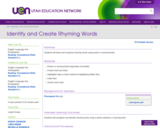
Students will listen and recognize rhyming words using poetry or rhyming books.
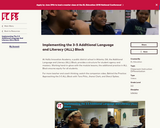
At Hollis Innovation Academy, a public district school in Atlanta, GA, the Additional Language and Literacy (ALL) Block, provides a structure for student agency and mastery. Working hand-in-glove with the module lessons, the additional practice in ALL Block ensures equity for all students.
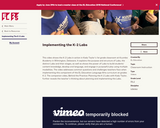
This video shows the K-2 Labs in action in Kady Taylor's 1st grade classroom at Kuumba Academy in Wilmington, Delaware. It explains the purpose and structure of Labs, the distinct Labs and their stages, as well as shows the power of Labs to build students' content knowledge, develop oral language, and engage in purposeful play using multiple modalities. The video addresses common questions and challenges teachers face when implementing this component of the EL Education Language Arts curriculum at grades K-2. The companion video, Behind the Practice: Planning the K-2 Labs with Kady Taylor, further reveals the teacher's thinking about planning and implementing the Labs.
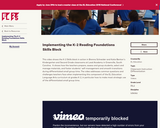
This video shows the K-2 Skills block in action in Brenna Schneider and Katie Benton's Kindergarten and Second Grade classrooms at Lead Academy in Greenville, South Carolina. It shows how the teachers prepare, assess and group students, select and manage materials, and foster students' self-management and smooth transitions during differentiated small group time. The video addresses common questions and challenges teachers face when implementing this component of the EL Education Language Arts curriculum at grades K-2, in particular how to make most strategic use of the differentiated small group time.
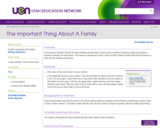
In this lesson students identify the ways families provide basic needs to their members.Students create and publish a booklet to display this information. This lesson is designed to have a class of older children buddy with the first graders to help with the reading and writing.
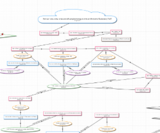
This Roadmap is an Informational Text Writing Unit. The unit begins with explaining what non fiction text is, the features of it, and how to write each section within it. Once the student has their first draft they begin with revision. They must prove the existence of certain features within their writing. The writing partner will also have the opportunity to evaluate their work. The partners for organization and ideas, sentence level revision, and editing for capitalization and spelling.

With KSPS's Injustice at Home: Overcoming Discrimination and Adversity (a series of four educational videos and a curriculum unit), grade school students will learn the stories of Frank C. Hirahara, Kazuko Sakai Nakao, Kaz Yamamoto, and Fred Shiosaki through oral history interviews. As survivors of the Japanese Incarceration
Camps during WWII, the powerful stories of these survivors reveal the damaging nature of racial discrimination upon the Japanese American community.
Throughout the unit, Grades 4-6 students will witness the fortitude and courage of those who suffered racial discrimination but overcame it due to the resiliency of their culture and character. Students will analyze paintings and poetry made by incarcerated Japanese American youth to determine the diverse impact on their daily lives. Students will conclude the unit by creating a biographical presentation of one of the survivors and demonstrate what can be learned from those who have experienced and overcome
discrimination.

Here at Innovation Classroom, we curate the latest and greatest in education technology as a resource for all teachers. See how education apps are changing the way we interact with students. Browse our collection of lesson videos to learn techniques you could be using in your classroom to engage your students in a new way. Search by lesson subject, teacher, grade level, device or app to find exactly what you're looking for. Technology that is integrated appropriately can open up a world of support, excitement and higher standards for all learners and educators in classrooms worldwide.
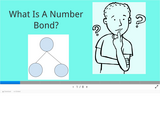
Students will understand what a number bond is and how they work.

Students will be able to differentiate the difference between a common noun and a proper noun. They will also be able to differentiate between a singular and plural noun.

Students will be able to identify subjects and predicates including simple and complete subjects and predicates.

Students will be able to distinguish the difference between action verbs, linking verbs and helping verbs.
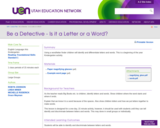
Using a word/letter finder children will identify and differentiate letters and words. This is a beginning of the year Kindergarten activity.

Students will determine whether each group has an even or odd number.
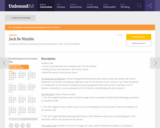
Students will:
• Listen to and demonstrate familiarity with “Jack Be Nimble”
• Identify Jack as the character in the nursery rhyme
• Retell the events of the nursery rhyme
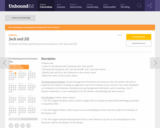
Students will:
9 Listen to and demonstrate familiarity with “Jack and Jill”
9 Demonstrate familiarity with “Jack Be Nimble” and “Little Jack
Horner”
9 Identify Jack and Jill as the characters in the nursery rhyme
9 Retell the events of the nursery rhyme